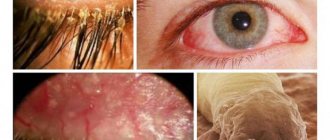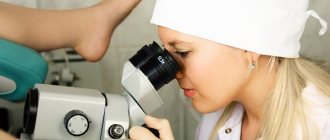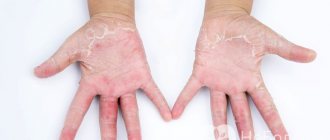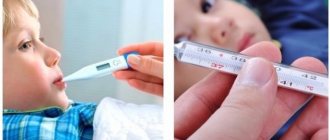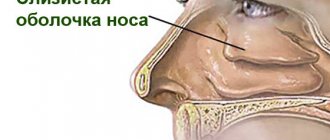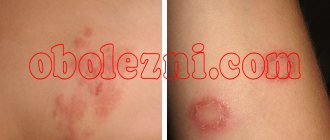Demodecosis is a skin disease caused by the demodex mite. It is also called the iron woman. It is transparent and invisible to the naked eye.
Normally, this mite lives on the surface of the skin of any person and is part of the normal microflora. Ticks feed on decay products in the upper layers of the epidermis. When the immune system malfunctions and other negative factors occur, mites multiply too actively and “settle” in the ducts of the sebaceous glands, causing inflammation. In addition to the skin, demodex affects the roots of the eyelashes.
What to do in such a situation? To get started, we recommend reading this article. This article describes in detail methods of controlling parasites. We also recommend that you consult a specialist. Read the article >>>
As an independent disease, demodicosis is not identified as a separate disease by most doctors, since it is always preceded by another pathology or poor hygiene. The disease often occurs against the background of acne, dematitis and rosacea. Inflammatory phenomena and vascular pathologies cannot but affect the state of the skin microflora, the balance is disturbed and the mite multiplies more actively.
Demodectic mange can be provoked even by prolonged exposure to the sun, which is stressful for our skin and causes a decline in local immunity. Violation of the rules of personal hygiene - rare change of towels and bed linen, rare washing, foreign cosmetics.
You shouldn’t get too carried away with hygiene either - frequent visits to baths and saunas can provoke a vascular reaction, which will cause demodicosis. Poor nutrition, prolonged use of hormonal ointments, and frequent acute respiratory viral infections affect the general and local state of immunity.
Causes of demodicosis on the face
Demodectic mange on the face affects a person regardless of gender or age. Demodex mites begin to multiply intensively under the following conditions:
- reduced immunity;
- hyperfunction of the sebaceous glands;
- constant stress;
- using cosmetics with hormonal supplements;
- bad ecology;
- disruptions in metabolic processes;
- changes in hormonal levels;
- during exacerbation of chronic diseases.
Bad habits (smoking, alcohol, coffee, spicy food), frequent visits to the sauna and solarium increase the development of the disease.
Hormonal changes lead to disruptions in skin PH. A slightly acidic environment becomes alkaline and enhances the growth of microorganisms. The increase, which does not have time to absorb dead individuals and sebum residues, provokes the appearance of yeast-like fungi, which causes irritation and itching on the skin. When scratching itchy areas, the skin becomes infected with streptococci and staphylococci.
Structure and characteristics of the parasite
Demodex in humans is an individual with a thin translucent body and four pairs of limbs. Females are larger than males. Scientists distinguish only two types of subcutaneous mites:
- Demodex brevis. These parasites live in the sebaceous glands of the skin. Their body is small - the length does not exceed 0.4 mm in females.
- Demodex folliculorum lives in hair follicles. This arthropod parasitizes not only on the body of women. In men, the parasite lives in the hair follicles of the beard, eyebrows, and eyelashes.
Infection with subcutaneous mites occurs without a reaction from the immune system. Individuals live in the upper layers of the dermis, so they do not cause resistance from the body. Representatives of these species of arthropods love a warm environment when the air temperature exceeds +30 0C. Therefore, an exacerbation of the dermatological manifestations of demodex occurs in the summer, during the intensive reproduction of mites.
Mites can leave hair follicles and move slowly across the skin at a speed of 8–16 cm per hour
The female lays eggs in the deep layers of the epidermis during hormonal imbalance, metabolic disorders and other changes in the body. The immune system begins to react to the appearance of foreign particles in the sebaceous glands (follicles), resulting in dermatitis characteristic of the pathology.
How to diagnose a tick?
To identify demodex mites, it is necessary to conduct a careful examination. To do this, a scraping of the epithelium is taken and examined under a microscope. During examination, it is not always possible to make an accurate diagnosis the first time.
If you have signs of demodex on your face, you should stop washing your face for 3 days, then go for examination. All waste products and dead individuals will be on the surface of the skin. Sometimes it is necessary to take eyelash and eyebrow hairs for examination. The mite may be in the mucous membrane of the eye, and can cause a relapse.
Symptoms of demodex on the face:
- formation of enlarged pores (an increased number of microorganisms does not fit in the follicles, causing an external skin defect);
- the appearance of red pimples with purulent filling;
- increased work of the sebaceous glands;
- gray skin color.
If eyebrows and eyelashes are damaged, their loss is observed, and the skin of the eyebrows peels off. Mites cause an unpleasant noise in the ears. The advanced form of the disease is characterized by a puffy skin condition with a yellow-brown tint, and ulcers at the site of acne. After a thorough examination, the doctor will advise how to cure demodex and how to behave during the illness.
Symptoms of subcutaneous mites
The subcutaneous mite most often affects people with oily skin. The subcutaneous mite belongs to the group of Ticks and has a microscopic size. It cannot be seen with the naked eye, but its body shape resembles a bug.
Subcutaneous mite
Today it is no longer a secret to anyone that the human body is a favorable environment for the life of a huge number of viruses, bacteria, fungi and other microorganisms. And if a couple of centuries ago this could have been taken for granted (given the then observance of sanitary and hygienic conditions), then in the 21st century humanity could make every effort to get rid of such an unpleasant neighborhood. But the simplest microorganisms are the basis; they inhabited our planet and everything that came and went on it for millions of years.
Interaction with various microorganisms sometimes harms a person, and sometimes turns out to be vital. For example, beneficial intestinal microflora or natural microflora in the female vagina ensure their work is coordinated and balanced in many respects.
This is a small mite, not visible to the naked eye, a subcutaneous mite. The size of the subcutaneous mite hardly reaches 0.4 mm; in appearance it looks more like a worm. Ticks find concentrations of subcutaneous fat a comfortable habitat. Sebaceous and sweaty skin secretions produced and not removed in time collect on the surface, filling enlarged pores - these are excellent conditions for demodex. More often it is detected in the fair sex, and the areas of the chin and nasolabial folds, brow ridges and eyelids, and forehead are more vulnerable.
What is demodicosis
If you have heard such a medical term as demodicosis, then know that it means a disease in which the skin is affected by a microscopic mite. Most often, subcutaneous mites are found on the face, in particular in the forehead and chin, on the eyelids, and in the nasolabial folds.
Demodex mites live in:
- hair follicles;
- sebaceous glands.
An adult subcutaneous mite has an elongated translucent body, up to 0.4 mm long. Demodex is covered with scales, with which it easily clings to hair follicles. This parasitic organism feeds on sebum and skin cells.
You will be surprised how many parasites will come out if you drink a glass of regular...
Parasites will leave the body in 3 days! You just need to drink on an empty stomach...
According to statistics, subcutaneous mites are found on the body in approximately 85-90% of people. Demodex is an opportunistic parasite that does not cause any harm if the immune system is good. Demodicosis occurs against the background of various diseases, stress, and can be observed during pregnancy.
If you want to see what a subcutaneous mite looks like, the photo below will provide an opportunity to examine the pest in detail.
Symptoms of demodicosis: signs of subcutaneous mites living in the body
At first glance, demodicosis is very similar to acne. So, girls and boys, women and men may experience pimples, rosacea and even pustules, small ulcers. At first, all this “decorates” only the face, but if treatment is delayed, the source of the disease can spread to the skin of the back and chest.
With demodicosis, pimples are most often localized in a specific place, for example, on the left or right cheek, on the chin, etc. Pimples can also line up in a row - this groove shows the path of movement of the mite.
You can suspect demodicosis based on the following signs:
- the skin around the nose and cheeks has become very oily, the pores on the face have expanded;
- the face became lumpy;
- the skin is red, itchy, and it feels like something is crawling on it;
- hair falls out a lot;
- There is itching at the roots of the eyelashes, itching of the ears.
With demodicosis, eye fatigue and swelling of the eyelids may occur. Plaque may also form along the edges of the eyelids.
Remember: regular pimples don't itch. If you notice that you want to scratch your face more and more often, do not delay visiting a dermatologist.
Factors causing the development of demodicosis
Demodectic mite actively develops if hygiene rules are not followed. Often a subcutaneous mite on the face is detected when:
- disruptions in the endocrine system;
- the presence of chronic diseases of the stomach, intestines, other organs and systems of the body;
- reduced immunity.
However, even those who have everything in order with their immunity can provoke a tick infection. Favorable conditions for the parasite to penetrate deep into the skin are created by squeezing out pimples, pustules and acne.
An outbreak of demodicosis can occur as a result of long-term use of certain medications (steroids, antibiotics), or the use of cosmetics that contain hormones.
The disease occurs:
- if you abuse the solarium;
- with frequent trips to the sauna/bath;
- with seborrhea, which is characterized by increased production of sebum.
Skin mites multiply intensively in spring and summer. A decline in activity is observed in winter.
Routes of infection
The likelihood of infection directly depends on a person’s compliance with hygiene measures and on the state of his immunity - how susceptible his body will be in the event of contact with demodex, which, by and large, can happen anywhere and to anyone, because it happens by:
- direct contact - from person to person, through a kiss, touching the skin;
- indirect contact - through household items (bed linen and towels, covers of transport seats, any fabric furniture and interior items).
However, it is not enough for a tick to physically land on a new host; it also needs to take root. It is in the interests of a person who does not crave such a neighborhood not to create conditions favorable for the life of the parasite, namely not to contribute to the accumulation of all kinds of impurities and naturally produced subcutaneous fat on his skin.
A person who has oily skin, and therefore a predisposition to demodicosis, is better off avoiding products that promote increased production of sebaceous substances. These are fatty, smoked, spicy foods, chocolate, coffee, alcohol.
The predisposition to the occurrence of demodicosis is determined by several other factors:
- dysfunction of the sebaceous glands and transformations in the composition of sebum;
- deterioration of the skin blood vessels;
- hormonal disorders;
- deterioration of environmental conditions for human life.
Pathogenesis of demodexosis
Like any living beings, subcutaneous mites begin to multiply excessively only in one case: the presence of excess food. Since under normal conditions these peaceful inhabitants of our skin feed on sebaceous secretions and particles of organic dirt, Demodex colonies usually begin to grow as a result of prolonged neglect of the rules of personal hygiene.
The ticks multiplied beyond measure, and the man suddenly washed himself, depriving them of food. Such population jumps are observed after every shower or bath, but it is worth taking into account the amplitude and duration of the “golden age” of demodexes. If usually the colony dies out before causing serious damage to the skin and leaving the same number of its fellows, optimal for combating pore-clogging sweat, in some cases these microscopic parasites lead to pathologies visible to the naked eye.
How to diagnose demodicosis
Even with good eyesight and a very careful examination of the skin at home, it will not be possible to identify skin mites. That is why it is impossible to do without laboratory diagnostics.
During the diagnosis, specialists will determine whether skin problems are really caused by the vital activity of demodex. If acne is excluded and demodicosis is confirmed, an effective course of treatment is prescribed.
Treatment options
Unfortunately, like all mites, demodexes are very tenacious.
Despite their very modest size, they have good protective armor - a cuticle, which acts on the principle of a chemical protection suit, preventing the medicine from destroying its owner. Because of this, dermatologists are forced to resort to serious tricks, combining different methods of influencing Demodex colonies and prescribing medications of various compositions.
Unfortunately, it is quite difficult to find one in a pharmacy - however, there are good analogues in veterinary stores (including ointment for horses). Chemicals that are dangerous for ticks include benzyl benzoate (sold as an ointment) and ornidazole. Of the herbal decoctions, demodexes are most afraid of calendula, eucalyptus and celandine; it is necessary to wipe the affected areas of the skin with them until they are completely brought back to normal.
How to get rid of subcutaneous mites using medicine
On average, demodicosis is cured in 1.5 – 3 months. Treatment is carried out using external means, which:
- have disinfecting properties;
- eliminate inflammatory processes;
- cleanse the skin of sebaceous secretions and substances that are released during the life of demodex.
The most effective local therapy is an ointment for subcutaneous mites. Excellent results are achieved by products that contain tar, zinc, and sulfur. These substances make it difficult for the subcutaneous tick to breathe, which leads to its death.
If the disease affects the eyeball, eye drops are prescribed. To stimulate the growth of eyebrows and eyelashes, it is recommended to rub burdock oil into the eyelid area.
Since demodicosis often occurs as a result of some kind of malfunction in the body, for a complete recovery it is necessary to address them. At the medical center, you can be given directions to donate blood to determine your sugar level, and be recommended to undergo examination by the following specialists:
- immunologist;
- nutritionist;
- gastroenterologist;
- endocrinologist;
- gynecologist and other doctors.
Traditional Treatments
Here are the signs that allow us to judge the presence of a parasite on a person’s face. Naturally, the treatment of subcutaneous mites must be competent and effective. Only compliance with these two conditions can lead to success. Therefore, if you suspect a disease, you should immediately consult a dermatologist. If the diagnosis of demodicosis is confirmed, the doctor will prescribe treatment. As a rule, it is complex and includes:
- drugs that strengthen the immune system;
- antibiotics if needed;
- antiparasitic agents;
- drugs that restore gastric secretion and its microflora;
- medications to strengthen the vascular wall, since the activity of the mite makes them fragile. In addition to medications, the patient is prescribed additional treatment, for example, cryotherapy, which is very popular today.
How to cure demodicosis with folk remedies
Demodicosis can also be treated with traditional medicine. The affected areas can be wiped with a decoction of juniper and elecampane. Rubbing with tincture of eucalyptus and calendula will improve the condition of the skin.
When it comes to innovative treatment methods, microdermabrasion has been gaining popularity in recent years. This term should be understood as a cosmetic procedure during which hardware resurfacing of the face is carried out. Professionals, using special devices, will be able to remove the mite-infested layer of skin, which will help get rid of demodicosis.
Microdermabrasion cannot be performed during an exacerbation of a skin disease, so before going to a beauty salon, consult a dermatologist.
Homemade ointments for demodicosis
You can prepare very effective ointments against demodicosis right at home. Both folk remedies and traditional medicines sold in every pharmacy will be useful to you. Their combination often works much better, and homemade ointment is cheaper than ready-made products.
Here are the best recipes:
- Buy trichopolum at the pharmacy. Every evening before going to bed, grind two tablets in a spoon of castor oil, and carefully apply the resulting ointment to the mite-affected eyelids. Rub it in lightly and leave until your morning wash;
- A simple folk remedy based on celandine will help eliminate demodicosis of the facial skin. Fill a glass of fresh roots with the same amount of refined sunflower oil, and leave the jar with this mixture in the sun for a couple of weeks. Then strain and store the resulting liquid in a dark glass bottle in the refrigerator. Mix it with sour cream and apply it to your face as an ointment before going to bed. Rub the same oily liquid into the skin of the eyelids and ears, and also bury it in the nose, because the mite lives there too;
- Get some natural apple cider vinegar at 6% concentration and use it as a healing ointment. Just make sure your eyes are closed tightly when you wipe your eyelids with vinegar.
Bitter wormwood will help against demodicosis
To prepare a healing decoction of wormwood, take a couple of tablespoons of dry crushed herb and pour a liter of boiling water over it, then boil for five minutes and leave in a warm place for at least three hours. This folk remedy for demodicosis is taken orally according to a special regimen for six days, without interrupting treatment even at night:
- Monday – half a glass every hour;
- Tuesday – half a glass every couple of hours;
- Wednesday-Saturday – half a glass every three hours.
For every day of such a “wormwood marathon” it is necessary to prepare a fresh portion of the decoction. You can sweeten it with honey. During treatment, you will not only eradicate the hated mite, but also perfectly cleanse the intestines.
Face masks against demodicosis
The unfortunate mite causes pink acne on the face, which greatly spoils the appearance. More precisely, the rash is caused not by the tick itself, but by its waste products. The sebaceous glands become inflamed, the pores expand and become clogged. What should I do? Folk remedies for demodicosis of the facial skin will help:
Any acidic juices, whether from berries, fruits or medicinal herbs, thoroughly spoil the life of ticks, depriving them of a nutrient medium. Prepare masks from lemon, blueberries, currants, celandine, mixing the sour treat with egg white if your facial skin is oily, or with yolk if it is dry;
There are herbs that have a soothing effect on irritated skin. We all know about them: they are chamomile, sage, calendula, string. You can prepare decoctions according to the instructions on the pack and apply sterile gauze soaked in the healing liquid to the face affected by demodicosis. These homemade masks are very effective;
Immediately after completing the procedure, rinse your face with whey and apply Lassara paste, which is easy to find at the pharmacy. In the morning, wash your face not with soap, but with special milk or baby shampoo. And then apply men’s aftershave cream to your face, preferably domestically produced.
Diet
The diet for subcutaneous mites is of great importance, and it must be very strict. You will have to completely eliminate honey, coffee, chocolate, spicy and salty foods, as well as fried foods. But you can consume fruits, vegetables, berry and herbal teas in unlimited quantities. In conclusion, I would like to remind you that strict adherence to personal hygiene standards in everything, a balanced diet and a healthy life will become a reliable barrier to the subcutaneous mite.
Skin care during treatment for subcutaneous mites
During treatment of demodicosis, it is better not to use cosmetics, in particular fat-based creams, which are good food for ticks. Even for washing, it is not recommended to choose gels and lotions from the store.
Therapy will be more effective if you give up alcohol and smoking, exclude fried and smoked foods, salty and spicy foods from your diet. During the entire course of treatment you should avoid:
- prolonged exposure to the sun;
- going to the sauna or steam bath;
- visits to the solarium.
Frequently changing towels and bed linen will help prevent re-infection with subcutaneous mites.
Sources:
- https://mama.ua/28033-izbavlyaemsya-ot-podkozhnogo-klesha-kak-lechit-demodekoz/
- https://100trav.su/lechenie-zabolevanij/podkozhnyj-kleshch-na-litse-simptomy-lechenie-foto.html
- https://ivona.bigmir.net/health/advice/393141-Kak-lechit—podkozhnyj-klecsh
- https://www.eurolab.ua/skin-problems-and-treatments/2544/2546/48177/
- https://www.ayzdorov.ru/lechenie_demodekoz_nar.php
Treatment options
Treatment for symptoms should be prescribed by a doctor depending on the type of bacteria and the severity of the disease. Typically, it takes 1 to 3 months to completely get rid of these parasites. Patients are prescribed antibiotics and antibacterial agents. Vitamins, lotions, masks, tar soap and even cryomassage are used.
How to treat damage to demodex mites should be decided by the doctor. As a rule, the entire course of treatment is divided into stages. First of all, they destroy the parasites living under the skin, and only then get rid of the consequences of their activity, acne and red spots.
The main difficulty in treating demodex bream on the face is that this arthropod is protected by a dense shell through which drugs penetrate poorly. That is why several remedies are used at once - antibiotics and special ointments, which have both an external and internal effect.
Is it necessary to use antibiotics?
Experts say that antibiotics for demodicosis are a last resort, the so-called heavy artillery. If you consult a doctor in the early stages of the disease, the following remedies will help in solving skin problems:
- vitamins;
- preparations with acaricidal effects;
- immunostimulants;
- lotions and creams that have a moisturizing effect.
If the problem has progressed to the point where demodicosis is not so easy to eliminate, drugs with antibiotic effects are used.
Express treatment
Not every patient will be morally inclined to undergo long-term treatment for subcutaneous demodex mites when they find out that parasites are crawling under their skin. Despite the fact that any inflammation must be treated comprehensively, there are several methods that make it possible to significantly speed up and simplify this process.
We are talking about the following procedures:
- Cosmetological facial cleansing (mechanical removal of acne). The advantages are quick relief from the symptoms of demodex. The downside is that cleaning cannot kill the pests themselves. Even after cleaning, mites will continue to exist and reproduce.
- Highly concentrated means of destruction. This technique literally allows you to get rid of damaged upper layers of facial skin. It develops burns similar to sunburn, and the skin begins to peel off. During the regeneration process, the upper layers come off and the lower ones become clean. However, the effect does not last long, because over time the tick makes itself felt again.
If these methods are used in combination with other procedures (how to treat demodex mites on the face is described in detail above), it is possible to get rid of parasites much faster and more effectively. That is why it is worth considering these methods in more detail.
Preventive actions
It is very important to monitor the condition of your skin. Adhere to personal hygiene standards, properly care for your facial skin and use care products. You should not use other people's cosmetics, as this leads to acne infection.
Nutrition and general health are also very important. It should be remembered that everything we eat in food sooner or later is reflected in our appearance, namely the condition and health of the skin. Eat healthy foods, balance your diet, eat more fruits and vegetables.
Eliminate processed foods and preservatives from your diet, minimize your intake of fatty foods, baked goods, and alcohol. Monitor your immune system, maintain it and strengthen it, as it is the main protective barrier of the entire body.
Face cleaning
Facial cleansing is a cosmetic procedure that allows you to quickly get rid of most visible skin imperfections, including acne and blackheads. There are two types of facial cleansing - manual and mechanical. If the first has been known since the times of the USSR, then the second appeared relatively recently and raises some doubts among most visitors to beauty salons.
Mechanical cleaning can be carried out only in cases where there are no open or closed comedones on the patient’s face. A comedon is a kind of “plug” that is formed due to blockage of the hair follicle. This is preceded by accumulations of dirt and sebum, blocking the pores.
If there are no comedones on the face and there are no other medical contraindications (individual intolerance to the drugs used), mechanical cleansing can be performed.
Stages of disease development
Dermatologists identify only four stages in the progression of subcutaneous mite infection. Each of them has its own clinical picture:
- At the initial stage, when the subcutaneous mite has just appeared on the face, infection with the parasite is expressed in the form of small redness, which quickly passes.
- If arthropods have settled in the follicles of the eyelashes, the patient has a feeling of the presence of sand in the eyes. Spider veins may also appear. This is the second stage of pathology development.
- In the absence of timely treatment measures, the disease progresses rapidly. Persistent red spots appear, pimples appear on the face, the localized areas of the spider veins increase, and the eyes look inflamed.
- The fourth stage in the development of pathology is the appearance of a progressive inflammatory process, accompanied by swelling. The nose turns red and becomes swollen. If the location of the parasites is the eyelids, rapid deterioration of vision is observed.
The sooner the patient contacts a dermatologist, the more effective the course of treatment will be. If demodicosis affects the follicles of the main scalp, an unpleasant odor appears, which is accompanied by hair loss.
It is quite easy to notice the lesion; the skin becomes dark gray, thickened, and pimples and blackheads often appear.
Mechanical facial cleansing
Quite often, mechanical cleaning is mentioned as one of the ways to treat the symptoms of demodex mites on the face. However, as has already become clear, with its help you can only get rid of the consequences of demodicosis, and the destruction of the parasite itself is somewhat more complicated.
Nevertheless, it is worth taking a closer look at this cosmetic procedure, because it can be done not only to eliminate deficiencies, but also as a preventive measure against their occurrence. Mechanical facial cleansing occurs in several stages:
- First of all, the patient’s face is treated with a composition that helps expand the pores. This could be a special cream, lotion or mask. After achieving the desired effect, the cosmetologist proceeds to the next stage of processing.
- Using sterile treated instruments, mechanical facial cleansing is carried out to remove blackheads and other formations. This procedure is also called comedone extraction.
- The final stage includes disinfection and the use of skin soothing products. As a rule, various tonics and lotions are used for this. Different cosmetologists may use products from different cosmetic brands in their work.
Do not apply makeup immediately after cleansing. After a while, the procedure must be repeated. The duration of the course is determined by a specialist and depends on the individual characteristics of the client.
Indications
Scraping for demodex is prescribed when there are characteristic signs of infection with the parasite, but sometimes the disease is asymptomatic.
Factors that provoke active reproduction of mites and progression of dermatosis:
- reduced immunity (due to diabetes, HIV, lupus erythematosus);
- hormonal pathologies;
- gastrointestinal diseases;
- abuse of coffee, alcohol, solarium, bath;
- stress.
Demodex infection is manifested by the following symptoms (they are also indications for analysis):
- redness, bumpiness, peeling of facial skin;
- rosacea, papules, purulent pimples, ulcerations, enlarged pores;
- itching in the ears, on the eyelids;
- gray tint of facial skin (observed in certain areas);
- partial baldness;
- discomfort when blinking, blepharitis (acute or chronic inflammation of the eyelids);
- loss of eyebrows, eyelashes covered with light scales;
- slight increase in the size of the nose (rhinophyma);
- pain during facial movements;
- itching of the facial skin when using cosmetics, as well as in the cold.
In the afternoon, it is time for Demodex to mate. At night, the parasite can leave the feeding site and migrate along the surface of the skin. In this case, the infected person is bothered by the sensation of crawling on the face.
The discomfort continues throughout the night, causing the person to suffer from insomnia. At the final stage of the disease, the skin thickens and turns into a conglomerate of bluish bumps and acne.
These signs do not always indicate infection with Demodex, but you can verify the absence of a mite only through analysis (scraping).
You should not try to relieve symptoms with cosmetics or antiseptics. This can provoke increased reproduction of the parasite, since Demodex readily feeds on some of them.
Women, in search of the causes of rashes, first of all turn to cosmetologists or gynecologists (to rule out the hormonal nature of the pathology), which is a mistake.
Without analysis and appropriate treatment, the situation will not change. Demodicosis itself is extremely rare, only in the initial stages, with no signs yet visible.
Folk remedies
For successful treatment, the following recommendations must be followed:
- Daily cleansing of the facial skin with a special gel for problem skin;
- Wash with warm water and then apply lotion;
- After this, medicated creams and ointments can be applied;
- Do not touch your face with your hands;
- Closely monitor the cleanliness of the skin and prevent contamination;
- Avoid direct sunlight;
- Get rid of the bad habit of squeezing pimples.
There are several effective treatment methods that can be carried out at home without having medications on hand:
- Mask with clay and herbs - dilute white or blue clay in a decoction of herbs (chamomile, calendula, nettle). Apply to cleansed skin, after drying (about 20 minutes), wipe off and rinse face with cool water;
- Herbal preparations - use petals of mint, string, plantain, nettle. They are crushed, poured with boiling water and allowed to brew. Drink 3-4 times a day before meals;
- Herbal infusions - used to wipe and cleanse the skin (tincture of calendula, wormwood, elecampane root);
- Tar soap – for washing (1-2 times a day).
It should be remembered that each person’s skin has its own characteristics, so an individual approach to treatment is necessary.
You need to be careful when using traditional medicine methods, because if used incorrectly, you can aggravate the course of the disease.
Methods for preventing the spread of demodex
Prevention of recurrence of subcutaneous mites is simple. It is based on compliance with generally accepted rules of personal hygiene:
- Cosmetics, towels, bed linen and clothing must be individual - each family member has his own personal set.
- If a daughter and mother (sisters, father and son) have common clothes in their wardrobe, they should be washed and ironed before each change of owner.
- Bed linen is washed at high temperatures and ironed. If there is no automatic washing machine, pillowcases, sheets and other components of the set are boiled down.
- After each workout in the gym, you take a shower. You cannot go home wearing the clothes you wore during training. At home, the tracksuit, cap, socks, and wristbands are washed.
- After contact with animals, be sure to wash your hands with soap. The risk of becoming infected with subcutaneous mites from a pet is minimal. Ticks that parasitize animals have a different nature and habitat. However, there is a risk of contracting infections and worms.
- For facial skin care, it is recommended to use fresh infusions of medicinal herbs (chamomile, calendula, St. John's wort), which have a powerful antiseptic and anti-inflammatory effect.
Following these simple rules will reduce the risk of infection with subcutaneous mites to a minimum.
Diet for illness
Proper nutrition plays a key role in the treatment of demodicosis. Nutrition is not only energy, but also macro- and microelements, vitamins and many other substances our body needs to fight disease.
You need to adjust your diet as follows:
- Avoid foods that contain large amounts of salt and sugar;
- Avoid fried, smoked, fatty foods;
- Quitting alcohol;
- Increase the content of vegetables and fruits in the diet;
- Add foods containing a large amount of fiber (bread, wheat, buckwheat, oatmeal, rice, potatoes, apples, carrots);
- A sufficient amount of fermented milk products (kefir, yogurt, milk).
Contraindications to the use of antibiotics
It is not always possible for a drug to be used by all people without exception. Medicines used in the treatment of demodicosis are strictly contraindicated for the following categories of people:
- pregnant women (especially during the 1st trimester), as well as women who are breastfeeding;
- people suffering from diseases and disorders of the nervous system;
- those diagnosed with liver disease;
- people with blood diseases.
Drinking alcohol or using decorative cosmetics may also be contraindications. To ensure that the treatment does not become protracted or cause damage to the body, it is important to pay attention to all the recommendations and prescriptions of doctors.
It is possible to defeat parasites!
Antiparasitic Complex® - Reliable and safe removal of parasites in 21 days!
- The composition includes only natural ingredients;
- Does not cause side effects;
- Absolutely safe;
- Protects the liver, heart, lungs, stomach, skin from parasites;
- Removes waste products of parasites from the body.
- Effectively destroys most types of helminths in 21 days.
There is now a preferential program for free packaging. Read expert opinion.
Interesting to know:
Symptoms and treatment of the disease
Treatment
When demodicosis of the skin or eyes occurs, there are two types of disease progression:
- primary is an illness that occurs independently, on clean skin, without accompanying pathologies (rosacea, acne, various dermatitis),
- secondary, occurring against the background of other diseases, often chronic.
The first symptoms, without consulting an experienced doctor, can easily be mistaken for simple acne. To clarify the diagnosis, a series of tests should be performed, hair follicles should be scraped, and, if necessary, seek the opinion of an endocrinologist or ophthalmologist. How to cure demodicosis when it progresses on the body?
Tissue of the sebaceous glands and scales on acne are taken for examination. The result is available in 2 – 3 days. You may not immediately detect the acne gland, so it is better to repeat the analysis a couple of times.
Primary demodicosis manifests itself suddenly, accompanied by characteristic symptoms and general deterioration of health. The face becomes covered with acne with reddish spots.
Effective treatment of demodicosis in humans takes a long time, from 2 months to a year, in courses, with breaks. The duration depends on the type and degree of damage. A comprehensive method is used, which includes:
- topical preparations (ointments: metragil, Klion, benzyl benzoate, erythromycin, sodium thiosulfate, sulfuric, yellow mercury, ichthyol, lindane),
- medicines for major diseases,
- desensitizing agents (tavegil),
- minerals, vitamins,
- antiparasitic medications (metronidazole),
- immunomodulators.
Ointments block the breathing of individuals. An excellent antiparasitic agent that blocks scabies, cream spray “Spregal”. It contains piperonyl butoxide and esdepalletrin.
In pharmacology, a special line of cosmetics for demodicosis “Stop Demox” has been developed: gel, shampoo, soap, spray, balm.
While the iron mite is being treated, it is better not to use other cosmetics. To wash your face, use herbal infusions instead of water. Calendula, chamomile, and yarrow have a disinfecting and healing effect on the skin. Daily use of tar soap enhances the bactericidal effect.
The treatment complex includes ozone therapy and magnetic therapy.
“Stop Demox”, remedies for demodicosis
Preventive measures for skin demodicosis in humans
If preventive measures are not followed, the parasites of the glandular acne have additional chances of developing into a disease.
Elementary rules that are easy to maintain throughout life will block the path to demodicosis. It is necessary to regularly change or heat treat personal hygiene items. Eliminate spicy, fried, salty and smoked foods from your menu. It is necessary to treat the underlying diseases.
During therapeutic procedures for demodicosis prescribed by the attending physician, you should not sunbathe, stay in the sun for a long time, or visit a solarium, bathhouse, or sauna. It is prohibited to receive cosmetic procedures.
